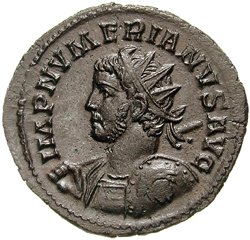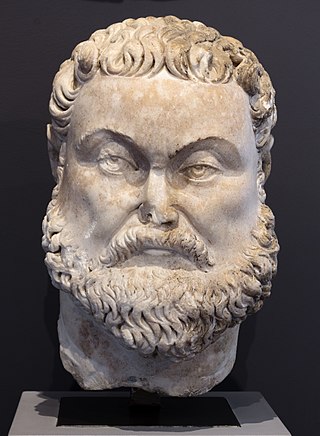
Diocletian, nicknamed "Jovius", was Roman emperor from 284 until his abdication in 305. He was born Diocles to a family of low status in the Roman province of Dalmatia. Diocles rose through the ranks of the military early in his career, eventually becoming a cavalry commander for the army of Emperor Carus. After the deaths of Carus and his son Numerian on a campaign in Persia, Diocles was proclaimed emperor by the troops, taking the name Diocletianus. The title was also claimed by Carus's surviving son, Carinus, but Diocletian defeated him in the Battle of the Margus.

The Tetrarchy was the system instituted by Roman emperor Diocletian in 293 AD to govern the ancient Roman Empire by dividing it between two emperors, the augusti, and their junior colleagues and designated successors, the caesares. This marked the end of the Crisis of the Third Century.
The 280's decade ran from January 1, 280, to December 31, 289.
The year 285 (CCLXXXV) was a common year starting on Thursday of the Julian calendar. In the Roman Empire, it was known as the "Year of the Consulship of Carinus and Aurelius". The denomination 285 for this year has been used since the early medieval period, when the Anno Domini calendar era became the prevalent method in Europe for naming years.

Flavius Valerius Constantius "Chlorus", also called Constantius I, was Roman emperor from 305 to 306. He was one of the four original members of the Tetrarchy established by Diocletian, first serving as caesar from 293 to 305 and then ruling as augustus until his death. Constantius was also father of Constantine the Great, the first Christian emperor of Rome. The nickname Chlorus was first popularized by Byzantine-era historians and not used during the emperor's lifetime. After his re-conquering of Roman Britain, he was given the title 'Redditor Lucis Aeternae', meaning 'The Restorer of Eternal Light'.

Numerian was Roman emperor from 283 to 284 with his older brother Carinus. They were sons of Carus, a general raised to the office of praetorian prefect under Emperor Probus in 282.

Maximian, nicknamed Herculius, was Roman emperor from 286 to 305. He was Caesar from 285 to 286, then Augustus from 286 to 305. He shared the latter title with his co-emperor and superior, Diocletian, whose political brain complemented Maximian's military brawn. Maximian established his residence at Trier but spent most of his time on campaign. In late 285, he suppressed rebels in Gaul known as the Bagaudae. From 285 to 288, he fought against Germanic tribes along the Rhine frontier. Together with Diocletian, he launched a scorched earth campaign deep into Alamannic territory in 288, refortifying the frontier.

Marcus Aurelius Carinus was Roman emperor from 283 to 285. The elder son of emperor Carus, he was first appointed Caesar and in the beginning of 283, with the title of Augustus, he was appointed co-emperor of the western portion of the empire by his father. Official accounts of his character and career, which portray him as debauched and incapable, have been filtered through the propaganda of his successful opponent, Diocletian.

Marcus Aurelius Carus was Roman emperor from 282 to 283. During his short reign, Carus fought the Germanic tribes and Sarmatians along the Danube frontier with success.

The Praetorian Guard was an elite unit of the Imperial Roman army that served as personal bodyguards and intelligence agents for the Roman emperors. During the Roman Republic, the Praetorian Guard were an escort for high-rank political officials and were bodyguards for the senior officers of the Roman legions. In 27 BC, after Rome's transition from republic to empire, the first emperor of Rome, Augustus, designated the Praetorians as his personal security escort. For three centuries, the guards of the Roman emperor were also known for their palace intrigues, by which influence upon imperial politics the Praetorians could overthrow an emperor and then proclaim his successor as the new caesar of Rome. In AD 312, Constantine the Great disbanded the cohortes praetoriae and destroyed their barracks at the Castra Praetoria.
The praetorian prefect was a high office in the Roman Empire. Originating as the commander of the Praetorian Guard, the office gradually acquired extensive legal and administrative functions, with its holders becoming the Emperor's chief aides. Under Constantine I, the office was much reduced in power and transformed into a purely civilian administrative post, while under his successors, territorially-defined praetorian prefectures emerged as the highest-level administrative division of the Empire. The prefects again functioned as the chief ministers of the state, with many laws addressed to them by name. In this role, praetorian prefects continued to be appointed by the Eastern Roman Empire until the reign of Heraclius in the 7th century AD, when wide-ranging reforms reduced their power and converted them to mere overseers of provincial administration. The last traces of the prefecture disappeared in the Byzantine Empire by the 840s.

The Dominate, also known as the late Roman Empire, is the "despotic" form of imperial government of the late Roman Empire. It followed the earlier period known as the "Principate". Until the empire was reunited in 313, this phase is more often called the Tetrarchy.

Marcus Aurelius Sabinus Julianus, known in English as Julian of Pannonia was a Roman usurper against Emperor Carinus or Maximian. It is possible that up to four usurpers with a similar name rebelled in a timeframe of a decade, but at least one of them is known by numismatic evidence.

In the Late Roman Empire, usually dated 284 AD to 602 AD, the regional governance district known as the Roman or civil diocese was made up of a grouping of provinces each headed by a Vicarius, who were the representatives of praetorian prefects. There were initially twelve dioceses, rising to fourteen by the end of the 4th century.
Protector Augusti Nostri was a title given to individual officers of the Roman army as a mark of their devotion to and approval by the Emperor himself. The term first appears with this meaning in the joint-reign of Valerian and Gallienus. Lucius Petronius Taurus Volusianus was the first recorded Protector appointed by Gallienus.

The constitution of the late Roman Empire was an unwritten set of guidelines and principles passed down, mainly through precedent, which defined the manner in which the late Roman Empire was governed. As a matter of historical convention, the late Roman Empire emerged from the Roman Principate, with the accession of Diocletian in AD 284, his reign marking the beginning of the Tetrarchy. The constitution of the Dominate outrightly recognized monarchy as the true source of power, and thus ended the facade of dyarchy, in which emperor and Senate governed the empire together.

The history of the Roman Empire covers the history of ancient Rome from the fall of the Roman Republic in 27 BC until the abdication of Romulus Augustulus in AD 476 in the West, and the Fall of Constantinople in the East in AD 1453. Ancient Rome became a territorial empire while still a republic, but was then ruled by Roman emperors beginning with Augustus, becoming the Roman Empire following the death of the last republican dictator, the first emperor's adoptive father Julius Caesar.
Titus Claudius Aurelius Aristobulus was a Roman soldier and politician who served as consul in 285 AD. He served two emperors, Carinus and Diocletian.











